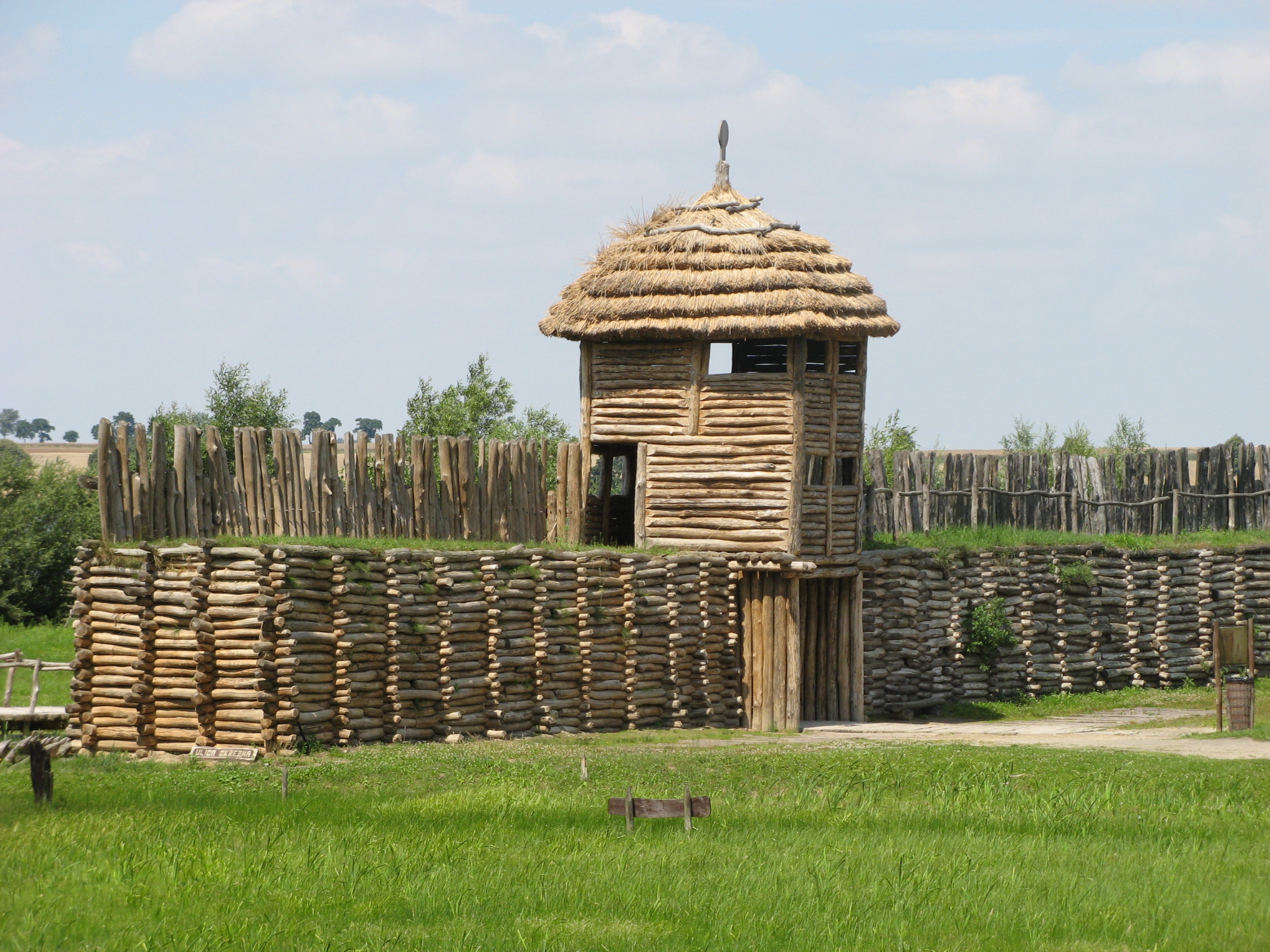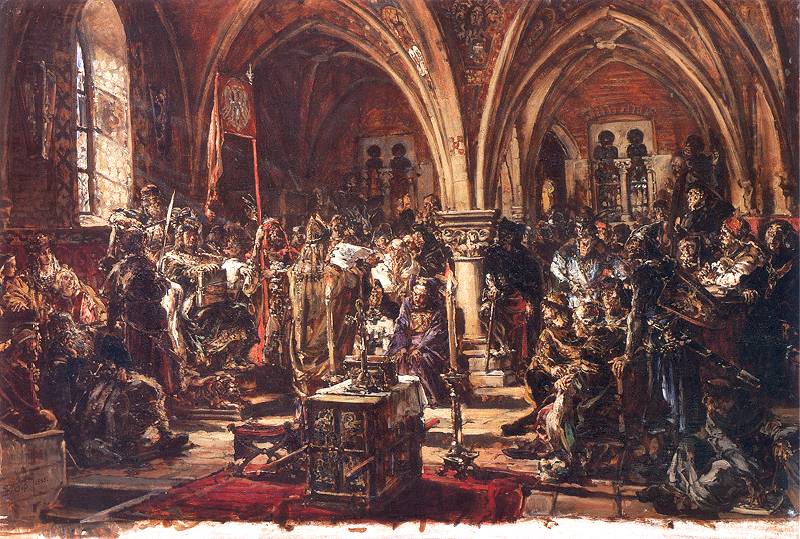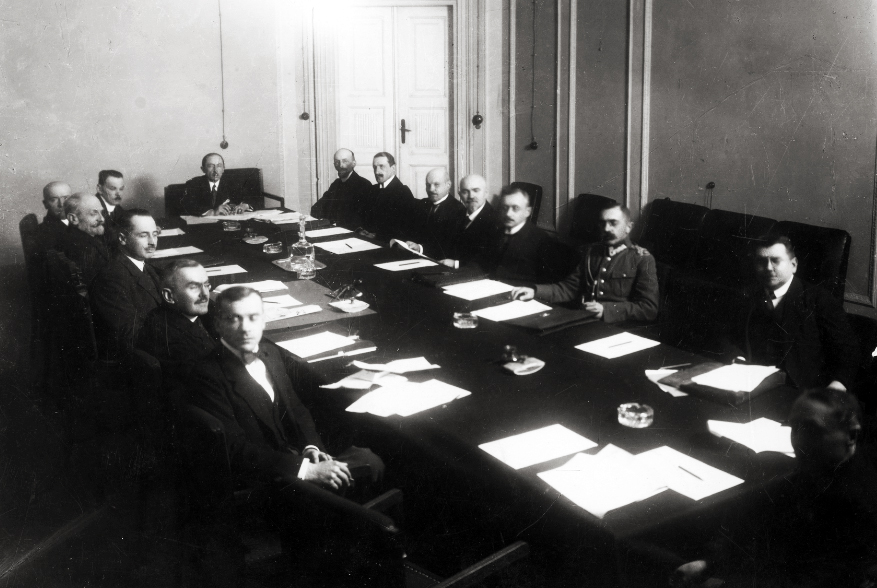|
Poland
Poland, officially the Republic of Poland, is a country in Central Europe. It is divided into 16 administrative provinces called voivodeships, covering an area of . Poland has a population of over 38 million and is the fifth-most populous member state of the European Union. Warsaw is the nation's capital and largest metropolis. Other major cities include Kraków, Wrocław, Łódź, Poznań, Gdańsk, and Szczecin. Poland has a temperate transitional climate and its territory traverses the Central European Plain, extending from Baltic Sea in the north to Sudeten and Carpathian Mountains in the south. The longest Polish river is the Vistula, and Poland's highest point is Mount Rysy, situated in the Tatra mountain range of the Carpathians. The country is bordered by Lithuania and Russia to the northeast, Belarus and Ukraine to the east, Slovakia and the Czech Republic to the south, and Germany to the west. It also shares maritime boundaries with Denmark and Sweden. ... [...More Info...] [...Related Items...] OR: [Wikipedia] [Google] [Baidu] |
History Of Poland
The history of Poland spans over a thousand years, from medieval tribes, Christianization and monarchy; through Poland's Golden Age, expansionism and becoming one of the largest European powers; to its collapse and partitions, two world wars, communism, and the restoration of democracy. The roots of Polish history can be traced to ancient times, when the territory of present-day Poland was settled by various tribes including Celts, Scythians, Germanic clans, Sarmatians, Slavs and Balts. However, it was the West Slavic Lechites, the closest ancestors of ethnic Poles, who established permanent settlements in the Polish lands during the Early Middle Ages.. The Lechitic Western Polans, a tribe whose name means "people living in open fields", dominated the region and gave Poland - which lies in the North-Central European Plain - its name. The first ruling dynasty, the Piasts, emerged in the 10th century AD. Duke Mieszko I is considered the ''de facto'' creator of the Polish sta ... [...More Info...] [...Related Items...] OR: [Wikipedia] [Google] [Baidu] |
Senate Of Poland
The Senate ( pl, Senat) is the upper house of the Parliament of Poland, Polish parliament, the lower house being the Sejm of the Republic of Poland, Sejm. The history of the Polish Senate stretches back over 500 years; it was one of the first constituent bodies of a bicameral parliament in Europe and existed without hiatus until the final Partitions of Poland, partition of the Polish state in 1795. The contemporary Senate is composed of 100 senators elected by a universal ballot and is headed by Marshal of the Senate (''Marszałek Senatu''). The incumbent Marshal of the Senate is Tomasz Grodzki. Following a brief period of existence under the Second Polish Republic, the Senate was again abolished by the authorities of the Polish People's Republic. It was not re-established until the collapse of the communist government and reinstatement of democracy in Poland in 1989. The Senate is based in Warsaw and is located in a building which forms part of the Sejm Complex on Wiejska Street ... [...More Info...] [...Related Items...] OR: [Wikipedia] [Google] [Baidu] |
Polish–Lithuanian Commonwealth
The Polish–Lithuanian Commonwealth, formally known as the Kingdom of Poland and the Grand Duchy of Lithuania, and, after 1791, as the Commonwealth of Poland, was a bi-confederal state, sometimes called a federation, of Crown of the Kingdom of Poland, Poland and Grand Duchy of Lithuania, Lithuania ruled by a common Monarchy, monarch in real union, who was both King of Poland and List of Lithuanian monarchs, Grand Duke of Lithuania. It was one of the largest and most populous countries of 16th- to 17th-century Europe. At its largest territorial extent, in the early 17th century, the Commonwealth covered almost and as of 1618 sustained a multi-ethnic population of almost 12 million. Polish language, Polish and Latin were the two co-official languages. The Commonwealth was established by the Union of Lublin in July 1569, but the Crown of the Kingdom of Poland and the Grand Duchy of Lithuania had been in a ''de facto'' personal union since 1386 with the marriage of the Polish ... [...More Info...] [...Related Items...] OR: [Wikipedia] [Google] [Baidu] |
History Of Poland (1918–1939)
The history of interwar Poland comprises the period from the revival of the independent Polish state in 1918, until the Invasion of Poland from the West by Nazi Germany in 1939 at the onset of World War II, followed by the Soviet Union from the East two weeks later. The two decades of Poland's sovereignty between the world wars are known as the Interbellum. Poland re-emerged in November 1918 after more than a century of partitions by Austria-Hungary, the German, and the Russian Empires.Norman Davies. ''Heart of Europe: The Past in Poland's Present''. Oxford University Press. 2001. pp. 100-101. Its independence was confirmed by the victorious powers through the Treaty of Versailles of June 1919, and most of the territory won in a series of border wars fought from 1918 to 1921. Poland's frontiers were settled in 1922 and internationally recognized in 1923. The Polish political scene was democratic but chaotic until Józef Piłsudski (1867–1935) seized power in May 1926 and de ... [...More Info...] [...Related Items...] OR: [Wikipedia] [Google] [Baidu] |
Warsaw
Warsaw ( pl, Warszawa, ), officially the Capital City of Warsaw,, abbreviation: ''m.st. Warszawa'' is the capital and largest city of Poland. The metropolis stands on the River Vistula in east-central Poland, and its population is officially estimated at 1.86 million residents within a greater metropolitan area of 3.1 million residents, which makes Warsaw the 7th most-populous city in the European Union. The city area measures and comprises 18 districts, while the metropolitan area covers . Warsaw is an Alpha global city, a major cultural, political and economic hub, and the country's seat of government. Warsaw traces its origins to a small fishing town in Masovia. The city rose to prominence in the late 16th century, when Sigismund III decided to move the Polish capital and his royal court from Kraków. Warsaw served as the de facto capital of the Polish–Lithuanian Commonwealth until 1795, and subsequently as the seat of Napoleon's Duchy of Warsaw. Th ... [...More Info...] [...Related Items...] OR: [Wikipedia] [Google] [Baidu] |
Sejm
The Sejm (English: , Polish: ), officially known as the Sejm of the Republic of Poland (Polish: ''Sejm Rzeczypospolitej Polskiej''), is the lower house of the bicameral parliament of Poland. The Sejm has been the highest governing body of the Third Polish Republic since the transition of government in 1989. Along with the upper house of parliament, the Senate, it forms the national legislature in Poland known as National Assembly ( pl, Zgromadzenie Narodowe). The Sejm is composed of 460 deputies (singular ''deputowany'' or ''poseł'' – "envoy") elected every four years by a universal ballot. The Sejm is presided over by a speaker called the "Marshal of the Sejm" (''Marszałek Sejmu''). In the Kingdom of Poland, the term "''Sejm''" referred to an entire two-chamber parliament, comprising the Chamber of Deputies ( pl, Izba Poselska), the Senate and the King. It was thus a three-estate parliament. The 1573 Henrician Articles strengthened the assembly's jurisdiction, makin ... [...More Info...] [...Related Items...] OR: [Wikipedia] [Google] [Baidu] |
Poland Is Not Yet Lost
( " Dąbrowski's Mazurka"), in English officially known by its incipit Poland Is Not Yet Lost, is the national anthem of the Republic of Poland. The original lyrics were written by Józef Wybicki in Reggio Emilia, in Northern Italy, between 16 and 19 July 1797, two years after the Third Partition of Poland erased the Polish–Lithuanian Commonwealth from the map. Its initial purpose was to raise the morale of Jan Henryk Dąbrowski's Polish Legions that served with Napoleon Bonaparte in the Italian campaigns of the French Revolutionary Wars. "Dąbrowski's Mazurka" expressed the idea that the nation of Poland, despite lacking an independent state of their own, had not disappeared as long as the Polish people endured and fought in its name. The music is an unattributed mazurka and considered a "folk tune" that Polish composer Edward Pałłasz categorizes as "functional art" which was "fashionable among the gentry and rich bourgeoisie". Pałłasz wrote, "Wybicki probably made ... [...More Info...] [...Related Items...] OR: [Wikipedia] [Google] [Baidu] |
Mazurek Dabrowskiego
( " Dąbrowski's Mazurka"), in English officially known by its incipit Poland Is Not Yet Lost, is the national anthem of the Republic of Poland. The original lyrics were written by Józef Wybicki in Reggio Emilia, in Northern Italy, between 16 and 19 July 1797, two years after the Third Partition of Poland erased the Polish–Lithuanian Commonwealth from the map. Its initial purpose was to raise the morale of Jan Henryk Dąbrowski's Polish Legions that served with Napoleon Bonaparte in the Italian campaigns of the French Revolutionary Wars. "Dąbrowski's Mazurka" expressed the idea that the nation of Poland, despite lacking an independent state of their own, had not disappeared as long as the Polish people endured and fought in its name. The music is an unattributed mazurka and considered a "folk tune" that Polish composer Edward Pałłasz categorizes as "functional art" which was "fashionable among the gentry and rich bourgeoisie". Pałłasz wrote, "Wybicki probably made u ... [...More Info...] [...Related Items...] OR: [Wikipedia] [Google] [Baidu] |
Partitions Of Poland
The Partitions of Poland were three partitions of the Polish–Lithuanian Commonwealth that took place toward the end of the 18th century and ended the existence of the state, resulting in the elimination of sovereign Poland and Lithuania for 123 years. The partitions were conducted by the Habsburg monarchy, the Kingdom of Prussia, and the Russian Empire, which divided up the Commonwealth lands among themselves progressively in the process of territorial seizures and annexations. The First Partition was decided on August 5, 1772 after the Bar Confederation lost the war with Russia. The Second Partition occurred in the aftermath of the Polish–Russian War of 1792 and the Targowica Confederation of 1792 when Russian and Prussian troops entered the Commonwealth and the partition treaty was signed during the Grodno Sejm on January 23, 1793 (without Austria). The Third Partition took place on October 24, 1795, in reaction to the unsuccessful Polish Kościuszko Uprising the previ ... [...More Info...] [...Related Items...] OR: [Wikipedia] [Google] [Baidu] |
Poles
Poles,, ; singular masculine: ''Polak'', singular feminine: ''Polka'' or Polish people, are a West Slavic nation and ethnic group, who share a common history, culture, the Polish language and are identified with the country of Poland in Central Europe. The preamble to the Constitution of the Republic of Poland defines the Polish nation as comprising all the citizens of Poland, regardless of heritage or ethnicity. The majority of Poles adhere to Roman Catholicism. The population of self-declared Poles in Poland is estimated at 37,394,000 out of an overall population of 38,512,000 (based on the 2011 census), of whom 36,522,000 declared Polish alone. A wide-ranging Polish diaspora (the '' Polonia'') exists throughout Europe, the Americas, and in Australasia. Today, the largest urban concentrations of Poles are within the Warsaw and Silesian metropolitan areas. Ethnic Poles are considered to be the descendants of the ancient West Slavic Lechites and other tribes that inhabi ... [...More Info...] [...Related Items...] OR: [Wikipedia] [Google] [Baidu] |
Religion In Poland
Poland has historically been one of the most religious countries in Europe, although surveys have found rapid and accelerating secularization. A 2018 survey by ''Pew Research Center'' found that, among those under the age of 45, the nation was the fastest secularizing among 106 nations measured. Though varied religious communities exist in Poland, most Poles adhere to Christianity. Within this, the largest grouping is the Roman Catholic Church: 91.9% of the population identified themselves with that denomination in 2018GUS, Narodowy Spis Powszechny Ludnosci 2011: 4.4. Przynależność wyznaniowa (National Survey 2011: 4.4 Membership in faith communities)' p. 99/337 (PDF file, direct download 3.3 MB). and, according to the Institute for Catholic Church Statistics, 36.7% of Polish Catholic believers attended Sunday Mass in 2015. Poland has historically been one of the most Catholic countries in the world; Neal Pease describes Poland as "Rome's Most Faithful Daughter." Roman Ca ... [...More Info...] [...Related Items...] OR: [Wikipedia] [Google] [Baidu] |
Prime Minister Of Poland
The President of the Council of Ministers ( pl, Prezes Rady Ministrów, lit=Chairman of the Council of Ministers), colloquially referred to as the prime minister (), is the head of the cabinet and the head of government of Poland. The responsibilities and traditions of the office stem from the creation of the contemporary Polish state, and the office is defined in the Constitution of 1997. According to the Constitution, the president nominates and appoints the prime minister, who will then propose the composition of the Cabinet. Fourteen days following their appointment, the prime minister must submit a programme outlining the government's agenda to the Sejm, requiring a vote of confidence.Article 154, para. 2 Conflicts stemming from both interest and powers have arisen between the offices of President and Prime Minister in the past. The incumbent and seventeenth prime minister is Mateusz Morawiecki of the Law and Justice party. Morawiecki replaced Prime Minister Beata Szydło, ... [...More Info...] [...Related Items...] OR: [Wikipedia] [Google] [Baidu] |






